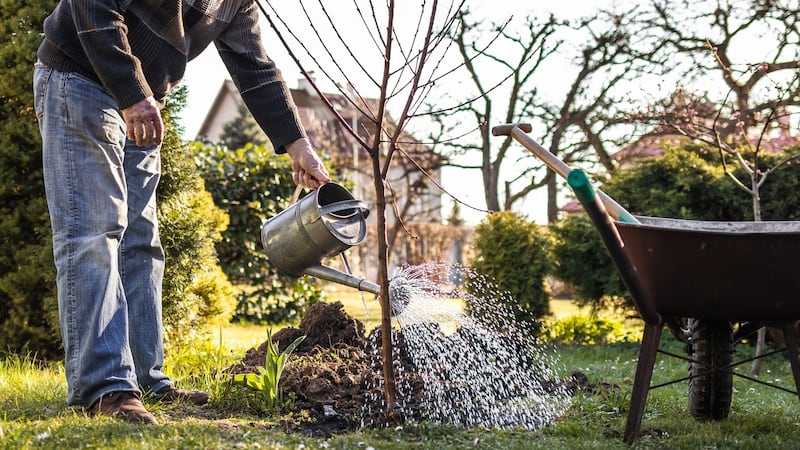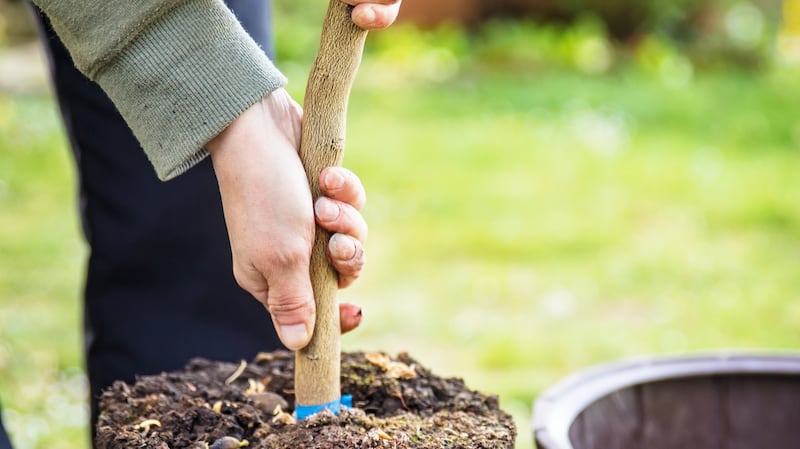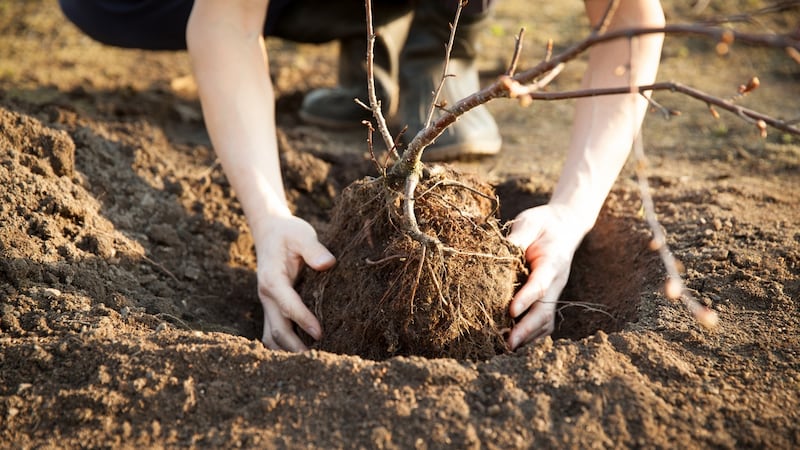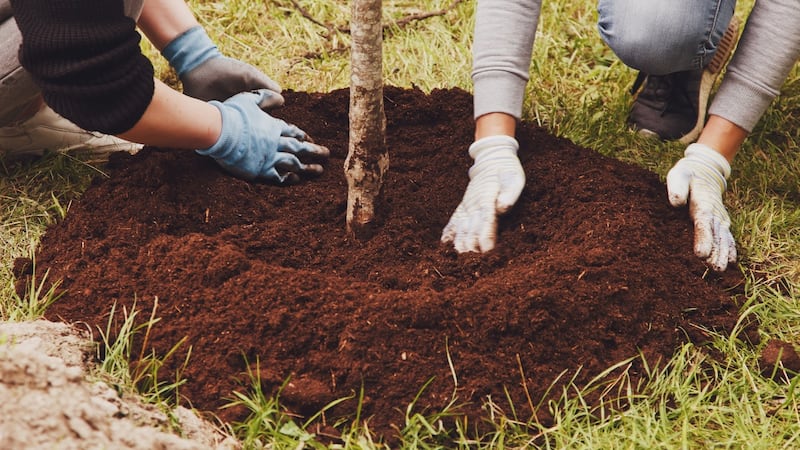Planting a tree seems, on the face of it, very straightforward. Short of planting it upside down, after all, what could possibly go wrong? You simply dig a hole, place the roots into said hole, backfill with soil, water generously, and Bob’s your uncle. Right? Not quite. With the busy bare-root season kicking off this month, here’s a handy little guide.
Container-grown, bare-root or root-ball
Container-grown trees are available to buy from nurseries and garden centres throughout the year while bare-root and root-ball specimens are only available during what’s known as bare-root season, which typically runs from the beginning of November to the end of March when deciduous species have dropped their leaves and entered a state of winter dormancy. The advantage of container-grown trees is that as long as they’re kept watered during dry spells, they can be planted at pretty much any time of the year. The disadvantage for gardeners is that they’re considerably more expensive than their bare-root equivalents as well as much heavier and bulkier to transport, which also makes them more expensive to ship, something to consider if ordering online. As the shape and size of their root systems are defined by the pots they’re growing in, they’re also often more labour intensive and time consuming to plant.

By comparison, bare-root specimens are considerably cheaper, easier to transport, kinder to the environment (there are no plastic pots or compost to worry about) and by virtue of their smaller root-ball size, less time consuming to plant. The downside is that their naked root systems make them much more vulnerable to damage and dessication, meaning extra care must be taken when it comes to transporting, storing and planting them. For this reason, they can only be planted during the bare-root season when the plants are dormant.
Available during the dormant season, root-balled trees are somewhere in between, with their (often-pruned) root systems not in pots but encased in soil and wrapped in a layer of protective hessian or plastic. Just like bare-root specimens, they need to be treated gently, stored carefully in a cool, dark place with their root systems kept damp, and planted as soon as possible after purchase.

Pick a healthy plant
Avoid container-grown trees with pot-bound root systems that have been starved of nutrients and constrained for too long. To check, gently pull the tree partially out of its pot. If the base of the rootball is a very dense mat of fibrous and woody roots with little compost left, then it’s almost certainly been in its container for too long. Also avoid trees with broken branches (especially if it’s the main vertical growing shoot, which will impact on its eventual size and shape) or an uneven silhouette. With bare-root and root-ball trees, choose healthy specimens with root systems that show no signs of having been allowed to dry out or left exposed to bright sunshine, warm temperatures or drying winds.
Right plant, right place
A much-quoted mantra that makes some gardeners groan, this is a cliché for a reason. By providing any particular species/variety of tree with the growing conditions that it needs, you’re already doing a huge amount to load the dice in its favour.
To help you make the right choice, take the time to carefully consider the aspect. Unless it’s overshadowed by the shade of nearby buildings and/or established trees and hedges, a south- or west-facing spot is considered full sun while north and east are considered cool and shady. Also consider your garden’s soil type (its fertility, structure, pH and ability to drain freely) and the local climate. Not sure? Take inspiration from local gardens that share similar growing conditions with yours and add the trees that flourish in them to your shortlist.

Ideally these will be species with proven resilience to pests and disease, that offer several seasons of interest and that can sit comfortably within the overall design of your garden as well as the larger landscape. Last but absolutely not least, consider the eventual size and spread of your chosen species/variety as well as its speed of growth. Is there a good chance that it will outgrow the spot you’ve chosen, or eventually cast too much unwelcome shade, or that its spreading root systems will stretch too close to the foundations of nearby buildings, walls, paving or underground drains? All good garden centres and nurseries have experienced, knowledgeable staff members that will be able to guide you in this regard.
Site preparation
No tree likes to be planted into weed-infested, compacted ground filled with buried builder’s rubble. So take the time to prepare the planting spot well, using a garden spade, fork and/or sturdy garden pick to remove the persistent, greedy root systems of perennial weeds and encroaching roots of established plants nearby as well as any large stones and builder’s waste.
Break up large clods and clumps where you can; the aim is to create something that’s nicely crumbly, friable and well-aerated. If the soil is very poor and stony, improve it by working in a little well-rotted organic matter (manure, homemade garden compost, or products such as enrich.ie). If it’s very poor-draining, work in plenty of coarse horticultural grit. But avoid the easy mistake of killing your tree with kindness by amending the soil with so much compost and/or well-rotted manure that the planting hole then acts as a sump that quickly fills with rainwater in winter. Likewise, over-modifying the soil can discourage a tree’s developing root system from spreading outwards in the hunt for fresh nutrients and water. The result is a constricted, less resilient, less stable root system with consequences for the long-term health and vigour of the tree.

A round or square planting hole
Traditional advice has always been to dig a round, deep hole but recent research suggests that a wide, square, shallower hole is best in terms of encouraging rapid, healthy root development. With bare-root specimens, make sure to gently spread their roots out in the planting hole before backfilling, aiming for a planting hole with an approximate width and depth of 150cm x 20cm.
Plant preparation
With container-grown or bare-root trees, make sure to give the roots a really good watering 30-60 minutes before planting. If they still seem dry, do this a couple of times or gently soak the root-ball in a barrow filled with clean water enriched with a little liquid seaweed to encourage good root establishment. If the roots show early signs of becoming pot-bound, gently loosen them out. Bare root specimens should have their roots entirely submerged in water for about 30 minutes before planting.
The correct planting depth
The most common mistake is to plant too deeply. Instead your newly-planted tree should sit in a very slightly raised mound of soil with its “trunk flare” – the point where its roots begin to spread out from the bottom of the tree –just above soil level (2-3cm). If in doubt, look for what’s known as the nursery line on the trunk and plant so that this meets the finished ground level. Always gently firm the soil with your foot as you backfill to get rid of any air pockets that might later cause the soil level to sink. For the same reason (as well as to hydrate the roots), gently but generously water the tree immediately after planting, then finish off with a shallow organic mulch, keeping it clear of the trunk.
To stake or not to stake
The once-conventional advice to stake all newly-planted trees has been overtaken by research suggesting it can do more harm than good by discouraging the development of strong, resilient root systems capable of dealing with local site conditions. Instead it’s now only recommended for larger specimens likely to suffer root-rock or those in extremely exposed sites.
When/if staking is required, use a timber stake or a double stake with a crossbar (the latter for larger trees) to a maximum height of 50cm, positioning it to the side of the tree facing the prevailing wind to avoid accidental wind damage to the trunk. To prevent permanent damage, disfigurement or girdling of the tree trunk (a kind of slow strangulation), staked trees must be regularly checked and their rubber tree-ties gently loosened where required, with the stakes completely removed a couple of years after planting.













